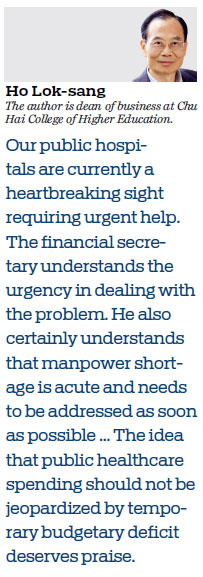The budget contains many original ideas
Updated: 2019-03-01 06:09
(HK Edition)
|
|||||||
Ho Lok-sang says the budget strikes a sensible balance between social and economic needs and is innovative in its approach to healthcare reform
Financial Secretary Paul Chan Mo-Po's latest budget has a number of pleasant surprises. Quite apart from the general tone of the budget being spot on in meeting the needs of the community and those of the economy, it has broken from the past in being innovative.
I am very much impressed with the decision of the government to allocate HK$20 billion

to purchase 60 properties for providing over 130 welfare facilities. It is a well-known fact that many social service providers have been seeking premises so they can better serve the community, and the government had not been able to find suitable sites to meet their needs. In particular, what social service providers need are premises close to their clients. The proposed initiative will dispense with the need to find new sites and to wait for the construction of the structures to house the facilities. Social service providers can then start offering their services within a year or two.
I am also very pleased with the decision to increase recurrent spending for public healthcare. In the past, due to excessive concern over fiscal prudence, the government had always preferred one-off spending over recurrent spending. This time, the government explicitly proposed an increase of over HK$700 million in recurrent funding for the Hospital Authority to implement measures to boost staff morale and retain talents, and another additional HK$400 million recurrent funding to expand the scope of the Drug Formulary. Rejuvenating our public healthcare is for me the top priority today. Our public hospitals are currently a heartbreaking sight requiring urgent help. The financial secretary understands the urgency in dealing with the problem. He also certainly understands that manpower shortage is acute and needs to be addressed as soon as possible. Although some doctors say that there is no shortage in the private healthcare sector, overall shortage is still pretty clear. In 2017, Hong Kong had about 1.91 doctors for every 1,000 people, as compared with South Korea's 2.3, Canada's 2.7 and France's 3.4. The imbalance between public sector and private sector only made matters much worse, because it is the public healthcare sector that the majority of Hong Kong people depend on. Moreover, almost all chronic and complicated cases go to our public hospitals.
Today, a total of HK$255.5 billion is allocated for education, social welfare, and healthcare. This represents 58 percent of the 2019-20 Budget and a 45 percent increase from 2014-15. Such a rise has sounded an alarm to some people. In a forum on the budget in which I served as one of the speakers, one commentator criticized the government for allowing public spending to exceed 20 percent of gross domestic product and not even mentioning this rule of thumb of confining public spending to no more than 20 percent of the GDP. But I am most pleased about this departure. There is absolutely no scientific reason why public spending should stay within 20 percent of the GDP. My own estimate for Hong Kong's optimal public spending, based on the World Value Survey, is closer to 30 percent than to 20 percent. The bottom line is just fiscal sustainability.
Paul Chan earmarked HK$10 billion as a Public Healthcare Stabilization Fund, "to ensure stable funding for public healthcare services and for coping with unexpected circumstances". The idea that public healthcare spending should not be jeopardized by temporary budgetary deficit deserves praise. In the past, we had made a mistake in cutting university places for medical students and HA recruitment of young doctors when the fiscal deficit rose to frightening levels in the wake of the Asian financial crisis. Chan's Public Healthcare Stabilization Fund will ensure such mistakes will not be repeated.
Last year, a report from KPMG says Singapore beat Hong Kong as the top Asian location for multinational corporations to set up regional headquarters. About 46 percent are stationed in Singapore, whilst only 37 percent are in Hong Kong. In 2008, 19.6 percent of the offices of all MNCs represented in Hong Kong were regional headquarters. In 2018 this figure fell to 17.5 percent. When we still think that our 16.5 percent profit rate is competitive, other countries are reducing theirs sharply over the years, and most also have various allowances or tax incentives for corporations. US President Donald Trump, for example, cut the federal corporate tax rate from 35 percent to 21 percent. The Hong Kong Financial Services Development Council in a 2017 report wrote: "In an ever increasingly competitive global environment, Hong Kong should continue to look at ways of ensuring that its tax regime remains competitive and attractive to businesses operating within the city."
My proposal to improve our competitiveness to lure regional headquarters to Hong Kong is this: We can tax only X percent of retained corporate profits, and also to tax only X percent of dividend payouts. This means that both retained earnings and paid-out earnings are treated equally, and that there is no double taxation. Thus if only 80 percent of retained earnings are taxed, and if no dividend is paid out, then effectively the profit tax rate is only 13.2 percent. Since many corporations do pay out a dividend, this means that the government will collect a tax from dividend income, and revenue loss will be minimal.
(HK Edition 03/01/2019 page12)